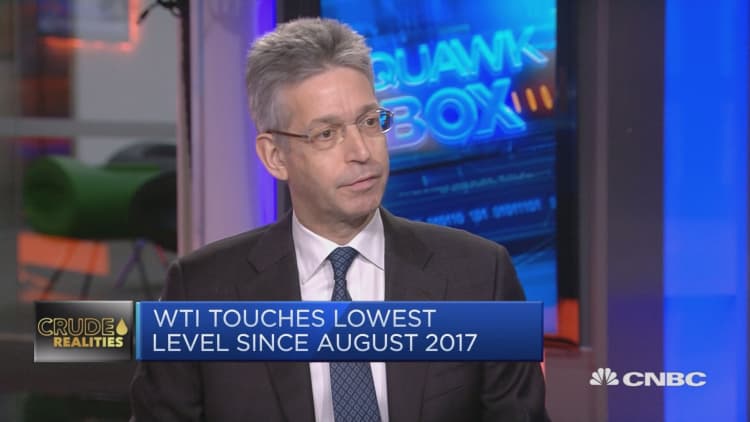Oil prices rose on Wednesday, recovering somewhat from a sharp sell-off during the previous session, after U.S. data showed strong demand for refined products.
Sentiment remains negative, however, as investors grapple with weakening demand and worries about oversupply.
Benchmark Brent crude oil settled 98 cents, or 1.7 percent, higher at $57.24 a barrel. The front-month U.S. light crude contract, which expires on Wednesday, closed 96 cents higher at $47.20 a barrel, a 2.1 percent gain. The second-month contract was up $1.10 a barrel to $47.70 around the settlement.
The markets slumped on Tuesday, extending a recent run of poor performance. Global benchmark Brent tumbled 5.6 percent on Tuesday, just above a 14-month low reached during the session, while WTI lost 7.3 percent, falling to its lowest level since August 2017.

Crude inventories fell by 497,000 barrels in the week to Dec. 14, smaller than the decrease of 2.4 million barrels analysts had expected. The decline was the third consecutive decrease, the U.S. Energy Information Administration said.
Distillate stockpiles, which include diesel and heating oil, fell by 4.2 million barrels, versus expectations for a 573,000-barrel increase, the EIA said. Distillate demand rose to the highest since January 2003, which bolstered buying, particularly in heating oil futures, the market's proxy for diesel.
Heating oil futures gained 2.8 percent to $1.803 a gallon.
"The complex is piecing together a modest advance so far today but only one that offsets a miniscule portion of recent losses," Jim Ritterbusch, president of Ritterbusch and Associates, said in a note.
Broader financial markets have been under pressure on worries that higher U.S. interest rates could slow domestic growth.
Crude futures briefly pared gains after the Federal Reserve raised its benchmark interest rate on Wednesday. The stock market turned negative and the U.S. dollar strengthened following the announcement. Oil is sold in dollars, so a stronger greenback makes crude more expensive for holders of other currencies.
Brent has lost more than 33 percent of its value and WTI has fallen 38 percent since the beginning of October as crude supply has increased.

The Organization of the Petroleum Exporting Countries and other oil producers including Russia agreed this month to curb output by 1.2 million barrels per day (bpd) in an attempt to drain tanks and boost prices.
But the cuts will not happen until next month and production has been at or near record highs in the United States, Russia and Saudi Arabia.
The U.S. government has said shale production should climb to over 8 million bpd for the first time by the end of December. Global oil supply faces pockets of disruption.
Russian oil output has been running at a record 11.42 million bpd so far this month, an industry source told Reuters.
Saudi Arabia's energy minister, Khalid al-Falih, said on Wednesday he expected global oil stocks to fall by the end of the first quarter.
— CNBC's Tom DiChristopher contributed to this report.

